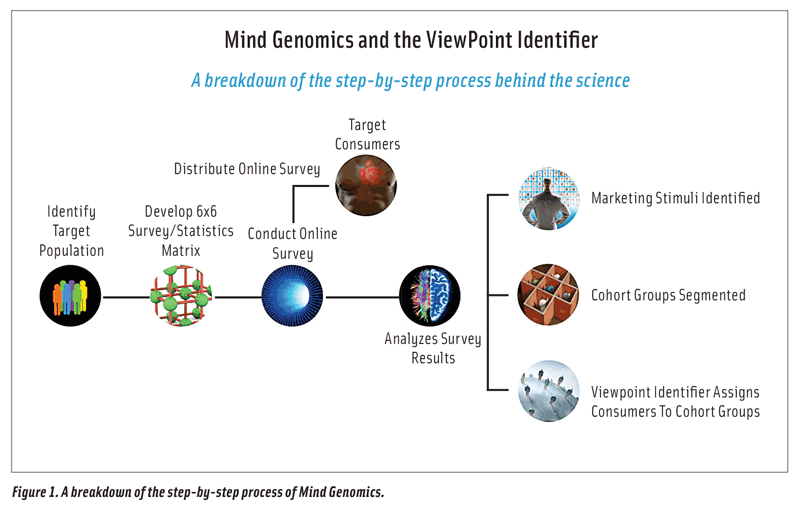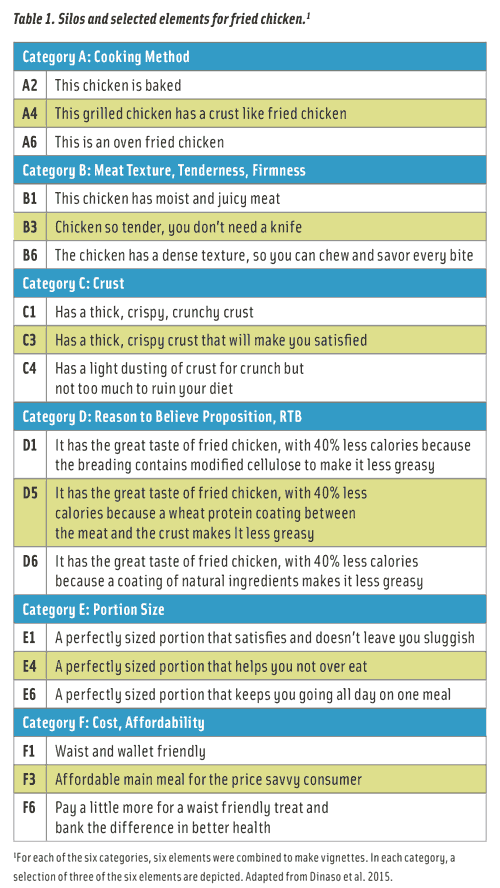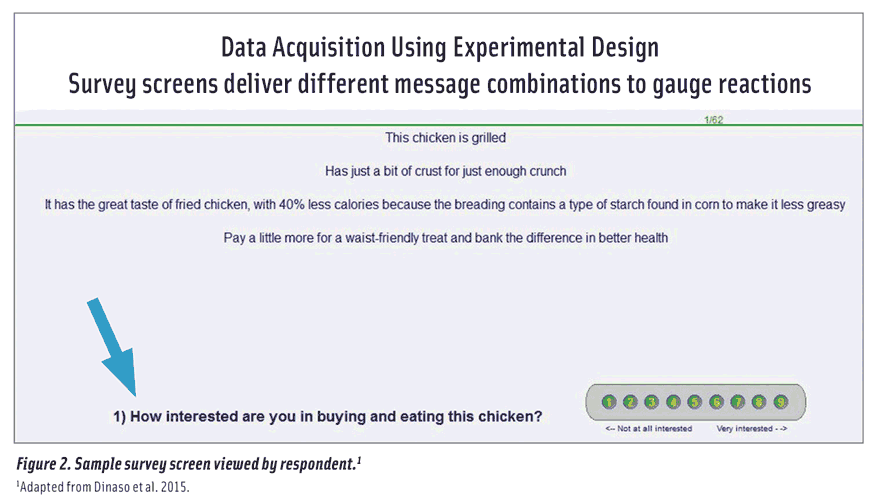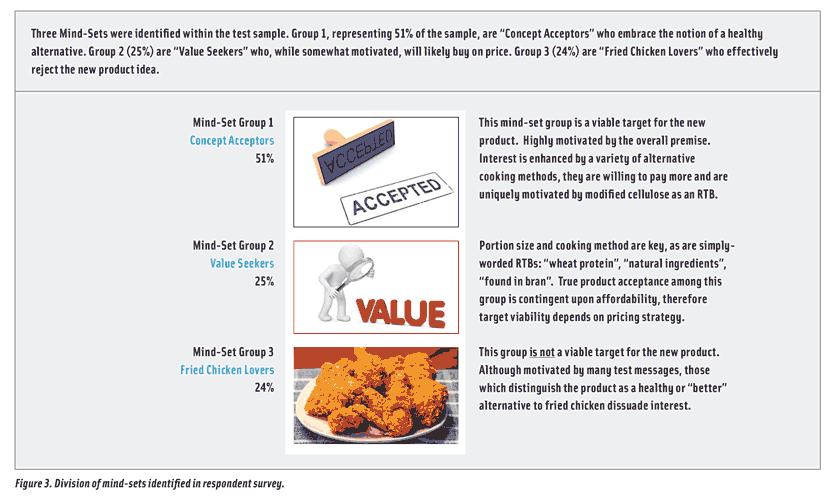Influencing Consumer Choice for Healthier Products
Through Mind Genomics experimentation, researchers can discover which messages resonate with consumers and uncover new mind-set groups that food companies can target with innovative, healthier products and meaningful marketing claims.

In the years following the 1997 proclamation by the World Health Organization that obesity is a global epidemic, the vast number of publications by academic institutions and government agencies have failed to identify a simple causative agent or mitigation strategies. In 2013, 44,000+ research articles were published on the topic of obesity and health consequences—heart disease, type 2 diabetes, stroke, some cancers, sleep apnea, mental illness, and low quality of life, respectively (USDA 2010, CDC 2015a). The relation between obesity and health consequences is particularly worrisome when we realize that an estimated 35% of the U.S. population is obese, according to the Centers for Disease Control and Prevention (CDC 2015b). This 35% translates to 78+ million Americans. Even more important is that American adult populations are differentially affected; 47.8% of non-Hispanic blacks, 42.5% of Hispanics, 32.6% of non-Hispanic whites, and 10.8% of non-Hispanic Asians are obese (CDC 2015b).
Obesity is a complex, chronic disease rooted in the subtle interrelation among many variables—energy balance, biology, culture, education, income, environment, food deserts, and food messaging. The last variable, food messaging, is particularly compelling because in one way or another we all are subject to advertisement by our daily exposure to packaging, television, radio, billboard, newsprint, and online reports and commercials.
The good news is that Americans are becoming more health-conscious. In 2014 the primary determinants for Americans’ choice of foods and beverages were taste (90%), price (73%), healthfulness (71%), and convenience (51%) (IFIC 2014). In the five years since 2010, taste and price have not changed significantly. Healthfulness has risen as a factor from 58% to 71%, whereas convenience dropped from 56% to 51%. The bad news is Americans’ trust in food manufacturers to provide accurate information about nutrition, physical activity, and weight loss is extremely low (≤5%) versus other sources, including web-based resources (≥14%) and health professionals (≥50%) (IFIC 2014). Not every piece of information is true either; some web-based resources are simply unreliable, presenting possibly false information.
It is clear that many American consumers are confused by food messaging. Text, graphics, and geometry communicate nutritional information while evoking the desired emotional response. General themes such as taste, appearance, organic, natural, fresh, locally grown, sustainable, shelf-stable, healthy, GMO-free, heritage, need, processed, fun, happiness, inclusion, culture, and adventure compete for our attention, and create feelings within us. Food messaging ranges from simple expressions that communicate what an apple is (It’s an apple) to highly sophisticated concepts which compel consumers to “Open happiness” using phrases that don’t define what the product is.
Our article explores how food messaging can be effectively used to mitigate obesity by encouraging consumers to change their food-related habits when purchasing and consuming. We acknowledge that each individual is responsible for making food decisions which is in his or her best interest. However, we additionally recognize that food environments do not always cooperate. There are “food deserts” and other hindrances to shopping for healthful foods. The food environments often flood with consumer messages purposely tailored to encourage consumption. There is some culpability in these externalities.
This article is intended to prod academia and industry to further develop and implement more persuasive and effective messages for food choices, illuminating a path for more healthful selections by consumers.
Promotion and Messaging
Much has been published about the promotion of unhealthy foods. A supermarket’s circular in the United States was demonstrated as featuring a higher proportion of unhealthy food choices (48.3%) in contrast to healthier options (35.1%), although the circular’s front page advertised both equally (Charlton et al. 2015). The UConn Rudd Center for Food Policy & Obesity report Snack F.A.C.T.S. (Food Advertising to Children and Teens Score) 2015 reported that compared to white children, black and Hispanic children see more television food advertising promoting savory snacks (UConn Rudd Center for Food Policy & Obesity 2015). Furthermore, language is brought in to convince whenever possible. For example, “fun” is used and may be abused in the advertising. Some Canadian foods designed for children use fun messaging (Fun to Eat, Mix up Some Fun), in addition to parental instructions proclaiming “there’s nothing fake for you to worry about”, “present new foods to your picky child in fun, colorful, and creative ways”, and “be a role model” (Elliott 2012).
Successfully designed packages are examples of messaging based on well-researched habits and preferences of consumers who do the shopping. The research provides guidance about what should be featured in order to drive a purchase, yet that information often does not provide the information necessary to drive health. For example, is a refrigerated processed food healthier than its comparable but processed shelf-stable equivalent? Are processed shelf-stable foods more or less healthful than comparable refrigerated, processed alternatives? Are processed foods, particularly those in a metal can, less healthful than a similar product purchased in a plastic oxygen-barrier package or glass? Are freely displayed vegetables and fruits more healthful than packaged vegetables and fruits? Does the design of a supermarket’s entrance and attractive display of foods make healthier foods an easier choice? Comparative examples are seemingly endless. There are so many questions, and so few straightforward answers. And though some of the above examples have intuitive answers, nevertheless, overt and subliminal messaging drives consumers to make choices.
To get a sense of the power of messaging, the next time you walk along any supermarket aisle, pay attention to colors, text, graphics, and geometries competing for your attention. Roughly 80% of food decisions are made in the grocery store (Elliott 2012). It has been estimated that about 90% of consumers decide which commodities to purchase by looking at just the front face of a package (Clement 2007). With this type of power, it is important to drive better messaging, colors, pictures, and words that move the customer to healthful choices.
The Allure of Fried Chicken
“Fried chicken hypnotizes people.” Dr. Michael Minor, undershepherd of Oak Hill Baptist Church in Hernando, Miss., used this expression during his 2012 interview with the Memphis Flyer (Ellis 2012). Known as the “pastor who banned fried chicken in his church,” Dr. Minor’s attempts to change the cultural unhealthy eating habits of some of his overweight and obese parishioners have been featured nationally. He used sermons, bible studies, and church bulletins to suggest other, more healthful eating habits, such as healthful ways to prepare chicken as well as preparing associated foods, including tea and desserts.
There is a lesson to be learned here. Fried chicken remains one of the most highly desired items in the fast food and QSR environments. “Fried chicken hypnotizes people” is an excellent example of a slogan to modify eating behavior. The slogan works because it relies upon an understanding of product preparation, specific food, peer influence, and the cultural significance of its appeal. Peer influence is especially important, having been demonstrated to be a fundamental reason why consumers eat specific foods (Nook and Zaki 2015). However, people differ, so what works with one group will not necessarily work with another. For example, when different phrases that describe a complete thought are shown to web-based respondents, different clusters or groups of responses emerge, some liking a message, others disliking the same message, and still others having no reaction at all. “Fried chicken hypnotizes people” worked for Dr. Minor’s audience, perhaps to some, but not to everyone. But still it worked sufficiently well to be noteworthy.
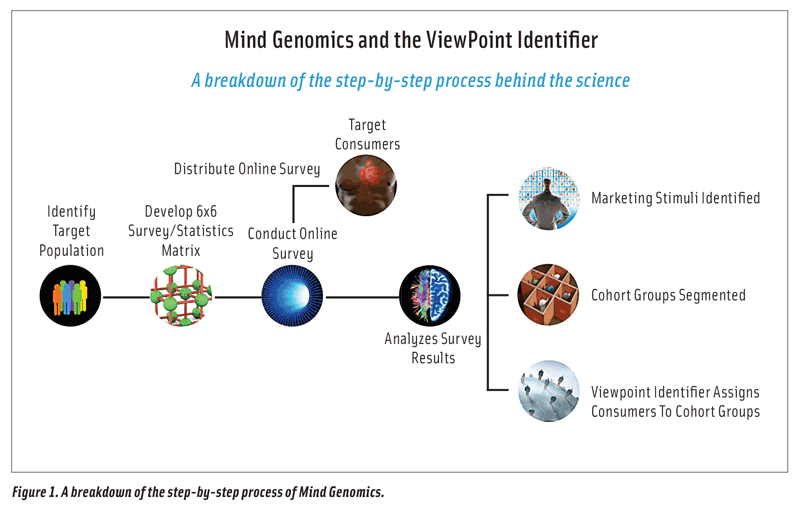 Many examples of food messages can be adduced to show which specific phrases work and which don’t. The work is empirical. The messages are created and vetted in tests to influence consumer choice. Mind Genomics, the experimental analysis of mixtures of ideas (conjoint analysis) created by author Moskowitz, is an experimentation-oriented technology that discovers which messages resonate with consumers, and uncovers possibly new-to-the-world groups of mind-sets, mind-set primaries if you will, people who respond to different sets of messages in the same topic area. The statistics-based research process is depicted in Figure 1. Mind Genomics experimentation identified those specific messages which drive interest in a healthier fried chicken, and so empowers one of the steps, proper messaging, for healthier eating and living (Dinaso et al. 2015).
Many examples of food messages can be adduced to show which specific phrases work and which don’t. The work is empirical. The messages are created and vetted in tests to influence consumer choice. Mind Genomics, the experimental analysis of mixtures of ideas (conjoint analysis) created by author Moskowitz, is an experimentation-oriented technology that discovers which messages resonate with consumers, and uncovers possibly new-to-the-world groups of mind-sets, mind-set primaries if you will, people who respond to different sets of messages in the same topic area. The statistics-based research process is depicted in Figure 1. Mind Genomics experimentation identified those specific messages which drive interest in a healthier fried chicken, and so empowers one of the steps, proper messaging, for healthier eating and living (Dinaso et al. 2015).
The Methodology of Mind Genomics
Mind Genomics is based upon a 6 X 6 matrix design, 36 basic ideas which can be used for the messages. Within the matrix, columns, termed categories, are general themes which define an aspect of a product or idea. Each category is populated with six easy-to-understand statements, termed elements, that communicate a complete thought that addresses the general theme. There is no assumption of any knowledge ahead of time, making Mind Genomics a knowledge development tool.
The creation of categories and elements can be challenging. Work has to be done, decisions have to be made. This rule applied to messaging as well. The messages don’t appear out of nowhere. They must be selected and only then exposed to consumers to determine which messages work. For this project, the categories for healthy choice chicken were cooking method, meat tenderness/texture, crust, reason-to-believe proposition (RTB), portion size, and cost affordability. The elements within each category are shown in Table 1. The transition words (e.g., this, has, a) and pronouns (e.g., you, your) are used to convey a sense of connection. We learned firsthand that when attempting to develop categories and elements, creativity and RTB are critical. If in the course of creating categories and elements you don’t believe in your idea, it is likely no one else will believe it either.
Once elements have been created, Mind Genomics algorithms show them to prescreened web-based respondents as systematically created vignettes. A vignette is like a small advertisement or barebones concept—something that you might see passing a store window. Each respondent evaluates 48 vignettes, and each element appears five times. Each respondent evaluates a unique set of 48 vignettes. The entire system is at some level a torture test for the elements. Respondents are only modestly interested, which is important. Rather than focusing on minute details as in focus groups, Mind Genomics experiments find what really works in an adverse situation, where the elements compete with each other.
The respondent task is easy. Individual respondents record their interest for each vignette using a 9-point scale that is tied to a rating question (e.g., How interested are you in this product?). The respondents do not have to justify their answers, but it’s easy to check whether the respondent is being consistent by computing the consistency of the responses. We know both what elements were present and what the respondent answered using the rating scale.
In addition to evaluating the 48 vignettes, the respondents completed a detailed self-profiling classification questionnaire which provided information about age, gender, education, attitudes and usage, and height and weight. The latter, height and weight, would later be used to calculate body mass index (BMI) to see whether BMI could predict responses to elements. That is, could we discover a link between one’s mind and an aspect of one’s body type?
The key to the Mind Genomics analysis are the individual impact values—the coefficients. Each message generates an average coefficient (the impact), estimated by regression analysis. These individual messages are “cognitively rich”, i.e., messages which by themselves are meaningful. The process of having the messages compete against each other and estimating the impact of each element through regression analysis in this naturalistic competitive frame quickly reveals what grabs attention in a positive way and what grabs attention in a negative way. Since the test cannot be “gamed,” as it is independent of the respondent’s desire to be politically correct, we end up learning about the mind of the respondent, i.e., the mind of the customer.
The data itself for each person, and thus for the average, begins with an additive constant, the propensity to be even interested in the product. Then each element generates its own coefficient, its impact value. Elements with impacts >5 are important. We interpret that as an additional 5% of the respondents would be positive when the element is inserted into the concept or vignette. Conversely, elements with impacts <-5 are deemed to be important, but negative as a driver away from interest. Ideally, we would like to create messages with strong positive elements, messages which break through and increase individual interest.
The population of our 222 web-based respondents was comprised of 29% males and 71% females; were aged 25–64; were 85% white/Caucasian; were responsible for all or most of their household shopping; were from households whose annual income was less than $39,000; were not associated with close family members or friends who worked in the poultry industry; and three months prior to survey participation, had purchased and eaten fried chicken in any of the following formats: platter, bucket, sandwich, or salad. They were, in a word, our target.
The fundamental interest of the study was to determine whether consumers “would accept the concept of a fried chicken-like product which met the criteria of taste, cost, convenience, and had fewer calories?”
Of the individual 36 messages, 10 messages which described cooking methods, meat tenderness/texture, crust, and cost affordability motivated interest in alternative cooking methods. For the total panel (mixing together the responses of 222 individuals) we uncovered 10 messages that looked promising. Message elements that contained chicken as “oven fried” (+8), “fried-like baked” (+6), “grilled” (+5, +7), “tender” (+7), “moist and juicy” (+5), “dense or chewy” (-7), “has a satisfying thick and crispy crust” (+6), that “is an affordable main meal” (+5, +7) resonated strongly with respondents.
There are some losing message elements as well. Despite the lure of technology, “new ideas” simply alienated the respondents. For example, in the RTB proposition of health for a new fried chicken product, most RTB propositions detracted from interest, especially those that included phrases about “modified starch” (-12) or “modified cellulose” (-9). Whereas these findings may seem obvious given the push for clean labels, phrases that included terms like “coatings of natural ingredients” or “coatings of ingredients found in bran” generated only near neutral interest. The bottom line here is that whereas the respondents showed an interest in alternative chicken products, we could as yet discover no compelling RTB, reason-to-believe.
Looking at the total panel, or even looking at people by who they say they are, or what they do, doesn’t necessarily get into their mind. There is “pay-dirt” when we divide our web-based panelists into groups based upon how they react to the messages. Our respondents can’t game the system because each vignette comprises 3–4 messages, so the respondent has to simply relax and rate the combination.
The data suggest three interpretable mind-sets, groups of people who look at the world of chicken the same way, based upon the pattern of impacts generated by the 36 elements (Figure 2). The fewer the number of mind-sets, the easier it is for companies to create and convey healthfulness in foods. The three mind-sets (Figure 3) are:
1. Concept Acceptors (51% of the sample; 76 additive constant). Concept Acceptors embraced the notion of a healthy fried chicken alternative. “Baked,” “grilled,” “grilled with a crust like fried” terms resonated well. Unlike total panel results, this group accepted terms like “modified cellulose” as part of the RTB. Also, they were willing to pay a premium as defined by the elements, “Pay a little more for a healthier meal and get a lot more satisfaction” and “Pay a little more for a waist-friendly treat and bank the difference in better health.”
2. Value Seekers (25% of the sample; 41 additive constant). For the Value Seekers, cooking methods and portion size were important. This group was also receptive to the RTB, but familiar phrasing and terms are important with this group (e.g., “It has the great taste of fried chicken, with 40% less calories because a wheat protein coating between the meat and crust make it less greasy”). “Pay a little more” and pricing vignettes showed very low impacts.
3. Fried Chicken Lovers (24% of the sample; 52 additive constant). The Fried Chicken Lovers Mind-Set is not a viable target audience. Fried, texture, and crust drive appeal and healthy RTB terms strongly dissuade interest in the Fried Chicken Lovers Mind-Set. This Mind-Set likely aligns with and resonates with the phrase “Fried chicken hypnotizes people.”
Although we might hope to find striking differences in receptivity to messages by body mass index, the BMI measured from the classification data, there were only modest differences. When grouped as under/normal weight or overweight/obese, the two groups were similar in their reactions to positive messages. It was the messages introducing new ideas, sometimes negative ideas, where the BMI groups differed. For example, in the under/normal weight group, the test messages featuring cellulose or starch, portion size, or dense, chewy texture were turn-offs with negative impacts. In the overweight/obese group, messages featuring chewy texture, cellulose, or starch remained negative, but portion size terms generated slightly positive or neutral interest.
Utilizing the Data
So what is the value of this information? What are the next steps to develop a more healthful fried chicken alternative? Is it product, or messaging, or both?
Our data suggest that a non-fried moist, juicy, tender chicken product that is grilled-like fried or baked-like fried using modified cellulose may be commercially viable. The combination of words shown to be positive motivators should be translated into the ingredients for a product that is now liked, based upon its sensory characteristics. The product development challenge is to bring to life a positive resonating message about the product.
But there is the policy challenge as well. Whereas it may be relatively straightforward to market a product modified to increase healthfulness to a predefined market that is known to be receptive to health and lifestyle, it is far more challenging to market to the general population about health and weight, especially when they continue to be exposed to so much conflicting information.
The opportunity to market and message health at a targeted individual level may, however, have arrived. From manufacturers to grocery retail chains, the food industry keeps information on the consumers of their products, some information at the group level, other information at the more individual, granular level. Using simple questionnaires to assign consumers to the appropriate mind-set for a product such as our chicken example opens up the possibility of the more effective messaging based upon an individual’s mind-set. In this study, the different mind-sets were shown to resonate differently to positive messages. Even more important, however, was what to avoid on a mind-set basis. There were many messages which were negative, but only to one mind-set, and not to the others. Identifying what not to say is an important component in messaging for healthier choice foods.
Not only the well-off foodies but also moderate to low income consumers appear to be concerned about ingredients on the food label. The overweight and obese seem to be less interested in the benefits of food ingredients and processing strategies which reduce the calorie value in poultry products. If the food industry is to succeed at providing consumers with health-promoting foods which meet the criteria of taste, cost, and convenience, more effective messaging must allay the fear of new processing methods and ingredients necessary to increase healthfulness. Addressing the fear of these novel processing variables must be incorporated into the scope of work.
Healthy Choice Food Messaging
When developing healthy choice food messaging, it is imperative to identify the problem to solve. And problems will involve identifying what consumers want. This in and of itself is a conundrum because when asked the vast majority of consumers have difficulty expressing what they want. Identifying and solving problems involve the collective development of categories, message elements, rating questions, survey screeners, and respondent populations.
Commercial viability for some healthy choice food alternatives will require that industry adopt some new strategies for food production. A nonfried, healthy choice chicken product is a good example. When messages which convince the consumer to want the product also are those which make the product taste good, at least from the test kitchen, then large-scale commercialization of grilled or baked chicken, for example, will result in a fundamental shift in how the poultry industry produces and supplies meat for restaurants. Today, on-site frying is completed within minutes because of par-frying, enabled by the frozen distribution cycle. Baking and grilling take longer, and although positive and healthful, are not compatible with today’s on-demand delivery of a chicken sandwich within 60 seconds of an order. Even now, adherence of breading and battering during distribution and cooking is a serious product development issue. Technology would likely need to be developed before we can replace fryers with grills or ovens.
We conclude this article on a positive note, with a short description of Bolthouse Farms, the producer and marketer of baby carrots. As reported by CBS News Sunday Morning (2013), marketing baby carrots as a healthy choice food to increase sales was abandoned in favor of specifically labeling carrots as an unhealthy snack. “Eat ‘em like junk food” is an advertising campaign that promoted baby carrots as a snack food similar to other junk food products. The former President of Coca-Cola North America and South America, Jeffrey Dunn, CEO of Bolthouse Farms, realized that Coca-Cola’s method of developing emotive phrases to encourage the consumption of and repeat sales of effervescent sugar water could be used to drive sales of carrots. Additionally, it was recognized that consumers of junk foods, particularly children, prefer to search a pantry or cabinet for a snack versus a refrigerator’s vegetable compartment. Consequently, Bolthouse Farms had to change behavioral expectations of where junk food-like, but healthy foods are stored. Thus, food messaging and packaging design can be used effectively to modify preferred snacking behavior, driving sales and increasing market share.
Johanna Dwyer (2015), in the 2015 Trailblazer lecture, outlined a systematic approach to resolve the collective failure to assure healthful eating. Recognition and respect the consumers’ need for choice is an important part of this systematic approach. Among other recommendations, Dwyer urged that we build appropriate enjoyment and pleasure into the food products we develop, but also enjoyment and pleasure implicit in the advice, i.e., the messaging, we give to consumers.
It is the hope that this article about healthy choice food messaging will positively influence steps toward healthful consumer eating behavior.
Academic-Industry Collaborations
One of the fundamental problems associated with product development, heathy choice food or otherwise, is to understand what consumers want. When asked, the vast majority of global consumers have difficulty communicating what they want. However, by sequencing and rearranging words that describe attributes, features, and benefits of an idea or service, it is possible to create messaging that can be aligned with the right person to commercially drive a product or idea forward.
Consumer choice results from a multitude of variables. From a private-public partnership, Mind Genomics showed us some probable successes for the ever-popular fried chicken. In that and three subsequent academic-private collaborations of consumer choice of baked desserts, blueberries, and snacks/nuts, we showed that tailored health messaging is one step in the process of behavioral change. Adult respondents to all surveys had annual household incomes of less than $39,000 and all recently purchased and consumed the products. By all measures, the respondents represented the consumer of interest to influence.
Tailored health messaging is one step in the process of behavioral change. Our next steps are “listening sessions” and applications of this approach to consumer choice. Our aim is to further academic-industry partnerships to promote health and accelerate easier, healthier consumer choices in the U.S.
John King, a member of IFT, is president of Apis Group ([email protected]). Louise Wicker, PhD, a professional member of IFT, is director, School of Nutrition and Food Sciences, LSU AgCenter ([email protected]). Howard Moskowitz, PhD, a professional member of IFT, is chief science officer of Mind Genomics Advisors ([email protected]).
References
CBS News Sunday Morning. 2013. Food Fight: Marketing Healthy Snacks Like Junk Food. Nov. 24. http://www.cbsnews.com/news/food-fight-marketing-healthy-snacks-like-junk-food/
CDC. 2015a. The Health Effects of Overweight and Obesity. June. http://www.cdc.gov/healthyweight/effects/index.html
CDC. 2015b. Adult Obesity Facts. September. http://www.cdc.gov/obesity/data/adult.html
Charlton, E. L., L. A. Kahkonen, G. Sacks, and A. J. Cameron. 2015. Supermarkets and unhealthy food marketing: An international comparison of the content of supermarket catalogues/circulars. Preventive Med. 81:168-173.
Clement, J. 2007. Visual influence on in-store buying decisions: an eye-track experiment on the visual influence of packaging design. J. of Mktg. Mgmt. 23(9-10): 917-928.
Dwyer, J. 2015. Trailblazer Lecture: Why are processed foods so controversial? J. of the Acad. of Nutr. and Diet. 115(11): 1871-1876.
Dinaso, C., L. Wicker, B. Krieger, and H. Moskowitz. 2015. How to Identify the Perfect Product Claim. World of Food Ingredients. March. CNS Media BV, Arnhem, Netherlands.
Elliott, C.D. 2012. Packaging Fun: Analyzing Supermarket Food Messages Targeted at Children. Canadian J. of Comm. 37(2): 303-318.
Ellis, S. 2012. Michael. O. Minor, “The Pastor Who Banned Fried Chicken,” To Speak Friday. Memphis Flyer.
IFIC. 2014. 2014 Food & Health Survey. International Food Information Council Foundation. http://www.foodinsight.org/articles/2014-food-and-health-survey
McGray, D. 2011. How Carrots Became the New Junk Food. Fast Company. April. http://www.fastcompany.com/1739774/how-carrots-became-new-junk-food
Nook, E. and J. Zaki. 2015. Social Norms Shift Behavioral and Neural Responses to Food. J. of Cognitive Neuroscience. 27(7): 1412-1426.
UConn Rudd Center for Food Policy & Obesity. 2015. Snack F.A.C.T.S. November. http://www.uconnruddcenter.org/files/Pdfs/SnackFACTS_2015_Fulldraft02.pdf
USDA. 2010. Report of the Dietary Guidelines Advisory Committee on the Dietary Guidelines for Americans, 2010. May. http://www.cnpp.usda.gov/sites/default/files/dietary_guidelines_for_americans/2010DGACReport-camera-ready-Jan11-11.pdf

